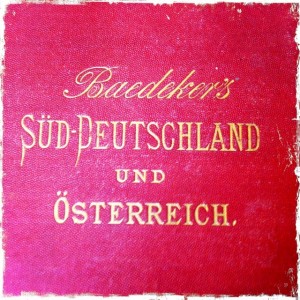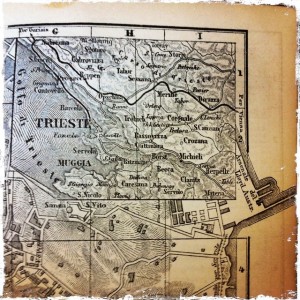Dear Naya,
I am staying at my sister’s house on the south coast of England for a few days. My brother-in-law Limor has a fine collection of antique Baedeker travel guides in various languages, from the late nineteenth and early twentieth centuries. On a rainy afternoon it is a lovely thing to lose yourself between their worn red cotton covers, to wander nostalgically across fin-de-siècle Europe. Although to call Baedeker’s descriptions terse would be an understatement, and there are of course no photographs or illustrations – only immaculately detailed street plans. Instead, his practical text gives just enough of a skeleton to hang your own images onto, allowing your imagination its own licence.
To flick through these volumes is to travel through space and time to a world where everyday concerns include the fares for the ‘Droschken’ (horse-drawn carriages) from the city of Trieste to the pleasure-palace of Castello Miramare, a journey of 1 ¾ hours (now a 10-minute bus ride). Baedeker explains that you will be able to gain entrance to the ‘dazzlingly decorated’ interior ‘by sending your card to the castellan’. From the port of Trieste, Austrian Lloyd steamboats depart once a week for Greece, Constantinople and the Levant, while a direct line to Alexandria goes every Friday, and the Bombay ship leaves once a month.
In just half of page, Karl Baedeker’s list of facts paints the most vivid of pictures. The port is “for southern Germany what Hamburg is for the north… 18,000 ships, 1600 steamboats, 1 million tons in and out every year. Value of imports nearly 145 million Fl., exports 117 million Fl. The residents of Trieste belong to a wide variety of nationalities; within the city the Italian element dominates, a sixth are Slavs and just 4800 Germans (though the German language is understood everywhere)…” You can’t help envisaging the teeming quaysides, the bustling stevedores, the cosmopolitan crows of merchants and travellers, the luxuries of extreme wealth, the energy of the very latest technology and engineering.
The later French-language edition of Allemagne du Sud & Autriche (1896) describes Sarajevo as a city of “numerous minarets (more than 100)”. The bazaar is the “principal curiosity of the town”, where you will require an interpreter to assist you with shopping. “Many articles sold as being oriental are in fact of Austrian origin”. A hut in the centre of the bazaar distributes coffee to the poor. In 1896 you could gain entrance to the Gazi Husrev-Beg mosque by addressing the warden by the gate and paying a small fee – just as you and I did a few weeks ago.
At that time, the Baedeker guides were so popular that ‘baedekering’ became a widespread term meaning travel to a foreign country in order to write a travelogue. More recently (in 1985) Henry Bernard Levin wrote in Hannibal’s Footsteps that “Baedeker is astonishingly enduring; travellers can use nineteenth-century editions with confidence, providing they take some elementary precautions. Many hotels will long since have disappeared, and the prices will be somewhat different, but if Baedeker says ‘On leaving the tunnel, the best view is on the right’, it probably still is, unless somebody has shifted the mountain, and his descriptions of scenery and where to go to see it at its best are still valid, as is practically all of his potted history.”
Excerpts from Baedekers Süd-Deutschland und Österreich, Mai 1882 and Baedeker Allemagne du Sud et Autriche, 1896 (from the collection of Limor Feingold)
Baedekers Süd-Deutschland und Österreich, Mai 1882
95. Triest (Seite 434)
Der grossartige Bahnhof liegt im N. der Stadt, 20 Min. von deren Mittelpunkt. Omnibus 30-40 kr.; Droschken Einsp. 50, Zweisp. 1 fl. 20 kr.; Handgepäck frei, Koffer 10-15 kr.
Cafés: Café Litke und Degli Specchi, an der Piazza Grande; Al Vecchio Tommaso, am Hafen, Beim Hotel de la Ville; Tergesteo, Teatro, im Tergesteum, am Theaterplatz; Stella Polare, Caffè Adriatico, bei der Post, von Deutschen bevorzugt; u.a.
Dienstmänner im Innern der Stadt bis 50kg 20 kr.
Dampfboote. Nach Muggia, Capo d’Istria und Pirano mehrmals tägl.; nach Parenzo, Rovigno, Pola täglich mit kleinen Privatdampfern. Fahrten des östreich. Lloyd: nach Venedig 3mal, über Istrien nach Dalmatien 3mal, nach Fiume 2mal wöchentlich; nach Griechenland, Constantinopel und der Levante 1mal wöchentlich; directe Linie nach Alexandrien jeden Freitag; nach Bombay 1mal monatlich.
Telegraphen-Bureau: Via della Dogana Nr. 926.
TRIEST, die Tergeste der Römer, der Hauptseehafen Oesterreichs, am n.ö. Ende des Adriat. Meeres, mit 72,005 (mit den Vorstädten 133,383, mit seinen Gebiet und Militär 144,437) Einw., 1719 unter Kaiser Karl VI zum Freihafen erklärt, ist für das südliche Deutschland, was Hamburg für das nördliche. 18,000 Schiffe, darunter 1600 Dampfer, mit 1 million Tonnen laufen jährlich eine und eben so viele aus. Der Werth der Einfuhr beläuft sich auf nahezu 145 Mill. Fl., der der Ausfuhr auf 117 Mill. Die Bewohner von Triest gehören den verschiedensten Nationalitäten an; innerhalb der Stadt herrscht das italienische Element bei weitem vor, ein Sechstel sind Slaven und nur 4800 Deutsche (mit der deutschen Sprache kommt man überall aus).
Der Hafen ist Hauptsitz des Verkehrs. Grossartige neue Hafenanlagen sind in den letzten Jahren entstanden und gehen iher Vollendung in nächster Zeit entgegen. Auf dem s.w. Molo Teresa der 33m hohe Leuchtthurm (Fanale marittimo). Neben dem Hôt. De la ille die *griech. Kirche im Inneren glänzend ausgestattet. – L. neben dem Hôt. De la ille der Palazzo Carciotti, mit grüner Kuppel. – N. mündet der 1756 vollendete Canal Grande, welche 333m lang und 15m tief in ie Neu- oder Theriesienstadt einschneidet. Der Canal liegt stets voll von Schiffen, welche ihre Waaren ausladen. Am Ostende desseleben die Kirche S. Antonio Nuovo, 1830 v0n Nobile im griech. Stil erbaut.
Baedeker Allemagne du Sud et Autriche, 1896
52. Excursion en Bosnie II. De Maria-Theresiopel (Budapest) à Sarajevo
SARAJEVO ou Serajevo (567 m.), I’anc. Bosna-Sérai, capital de la Bosnie, maintenant adminstrée par l’Autriche, est une ville de 26 268 hab., dont 15 787 mahométans, avec 2900 hommes de garnison, un archevêque catholique et un métropole grec. Elle est située dans l’étroite vallée de la Miljačka, au pied de hauteurs qui atteignent 1600 m. et ou arrive la rivière dans une gorge. Ses nombreux minarets (plus de 100) et ses petites maisons dispersées sur une grande étendue, dans des jardins, lui donnent un aspect très pittoresque. La population turque et serbe occupe surtout le versant de la montagne. Il ya entre la gare et la ville un camp retranché.
Basar, centre du commerce et de l’industrie, animé surtout le mercredi. C’est la principale curiosité de la ville. Il faut un interprète pour faire des achats. Beaucoup d’articles qui s’y vendent comme orientaux sont d’origine autrichienne. Il y a au milieu une maisonette ou l’on distribue du café au pauvres. A l’O., la mosque d’Ousrev-Beg (Begova Djamia), du XVIe s., qu’on peut visiter en s’sadressant au gardien (50 kr.; on met des socques pour entrer), et on peut même s’y assister à al prière à 3 h. de l’après-midi.
Dans la Czareva Oulica ou rue de l’Empereur, la principale de la rive g., la mosquée de l’Empereur, ou les Turcs peuvent hisser le drapeau du sultan le vendr. de midi à 1h.
DE SARAJEVO A ILIDZE: 7 kil., ch. de fer d’intérêt local qui a sa gare près de la manufacture de tabacs. – Ilidže (Kurhôtel, bon; restaur.) a des bain d’eaux thermales sulfureuses et occupe un joli site. Un omnibus conduit de là en ½ h. aux sources de la Bosna.


